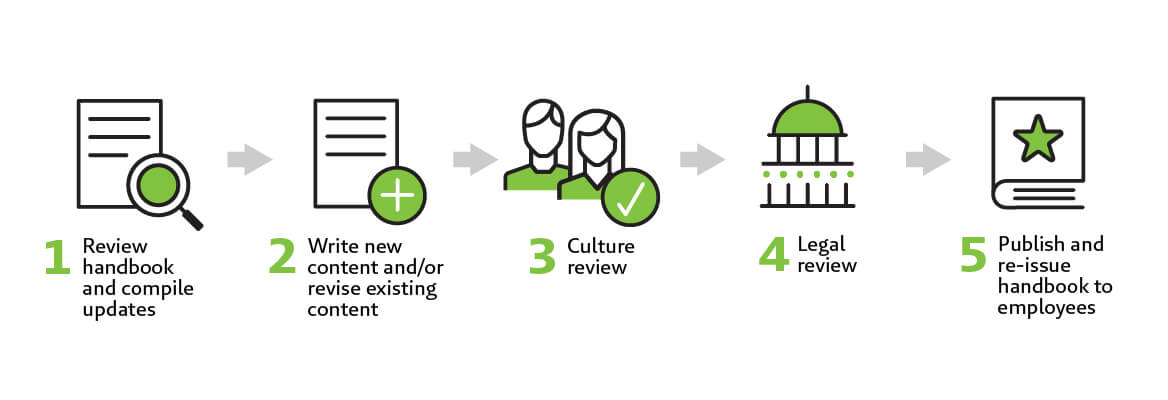Once you’ve created your all-important employee handbook and distributed it to your workforce, it’s easy to mark the project finished and forget about it for a few years. But what happens when new employees ask questions about an outdated policy? Or what if an issue comes up that the handbook doesn’t address?
Employee handbook updates are necessary – so now let’s walk through when they should happen.
When to make employee handbook updates
Your company and the world around it are not static entities. Change is constant and inevitable. As a result, employee handbooks should be dynamic, living documents. They must be maintained as internal and external conditions evolve, such as:
- Introduction of new federal, state or local laws
- Growing numbers of employees, thus subjecting the business to new laws and making your human resources (HR) more complex
- Expanded operations into other localities and states governed by new laws
- Broader scope of operations and services, including entry into new markets
- Changes due to larger cultural moments, along with employee expectations (a major, recent example being the rise of remote work and hybrid work brought on by the COVID-19 pandemic)
- Shift in the company mission, vision, values or culture
- Need to revise or implement new policies for any reason
Additionally, you may need to make small cosmetic updates over time, such as noting a change in company leadership or even just correcting typos.
Why employee handbook updates matter
Updating your employee handbook is important for:
- Ensuring compliance with ever-evolving federal and state law
- Keeping up with changes inside and outside your organization
- Maintaining consistency in practices and application of rules
- Providing a useful and relevant resource to employees and company leaders alike
On the flip side, never – or, at least, infrequently – updating your employee handbook could leave you with potentially negative consequences:
- The phenomenon of “old handbook, new reality” – you have an outdated document that doesn’t align with current workplace conditions and is therefore irrelevant to everyone
- Inability to enforce new, desired policies that aren’t written down, or hold anyone accountable if a rule is broken – you don’t have anything to fall back on if a policy isn’t in writing
- Confusion among employees as to which rules exist and are enforced
- Accusations of unfair treatment
- Misalignment with the company’s current mission
- Appearance of lack of compliance with the latest laws
How to make employee handbook updates
For some companies, necessary updates for their employee handbooks can arise so frequently that they could revise this document monthly. Of course, no one wants to do that – that’s not an efficient use of personnel time or resources, and employees could get exhausted from constant updates and confused about which version of the handbook to refer to.
A good cadence is to review and update your employee handbook every one to two years, maximum. Ideally, this is an annual exercise. Probably the only reason your company might consider updating its employee handbook more frequently is for a critical change, such as a new law taking effect on a certain date or a significant policy that must be addressed as soon as possible.
Annual employee handbook review: 5 steps

Steps 1-2: Review handbook and compile updates, and write or revise content
Coordinating what updates need to be made doesn’t need to be a one-time project within a tight timeframe. Throughout the year, your company’s HR team or a designated team member should:
- Review the employee handbook to ensure all information is up-to-date, and mark where revisions are necessary
- Confirm that the handbook contains the most relevant, important policies for your business – and that nothing is missing, even little-known but equally critical policies
- Identify new additions
- Check for any spelling or grammatical errors, and note those
This information should be compiled and saved for the next targeted update and publication date.
When revising content or writing new content for the employee handbook, in some cases you can rely on the verbiage of federal or state laws. The Society for Human Resource Management (SHRM) is also a good resource for obtaining boilerplate content.
When writing for an employee handbook, the main objectives are to:
- Be clear and concise
- Be comprehensive in scope (anticipate and address the most common questions employees will ask)
- Align with the company’s mission, vision, values and culture
Steps 3-4: Culture and legal review
Once you have created your revised employee handbook, perform a review to ensure that the new content aligns with your organization’s workplace culture. This answers the question: Who is involved in an employee handbook update?
The review can be carried out by executive leadership, the HR team or an employee committee comprising representatives from each department.
For the last step toward approval, your legal team should conduct a review to ensure that your employee handbook:
- Is in compliance with all applicable laws
- Has not unintentionally exposed the company to liability
- Has sufficiently addressed all critical issues
Step 5: Publish and re-issue to employees
Once all updates to the actual document are completed, the final question left is: Where do you share this information?
Typically, as part of an onboarding and orientation process, new hires receive a copy of the employee handbook. Then they sign a document acknowledging receipt of the handbook and that they’ve read and understood the content.
What about longer-tenured employees, many of whom signed off on an older version of the handbook? They also need to be aware of employee handbook updates. To enforce all workplace policies, you must be able to demonstrate that each employee is aware of the most recent content within the employee handbook.
Therefore, each time you update the handbook, date it – or give it a version number – and distribute it electronically to your entire employee population. Highlight the changes, and ask them to re-read the document, and sign and date an acknowledgement form. Keep this form with their signature and the date in each employee’s personnel file.
You may be tempted to just send a handbook addendum to employees showing the updates. In most cases, that’s not a good idea because it can be confusing for employees. It’s more documentation for them to keep up with, and it requires them to take an extra step of cross-referencing the changes with the existing content in the old employee handbook.
Giving your employees an entirely new handbook ensures that they have all the information in front of them, in one place. Overall, it’s simpler, and it better protects your company.
Additionally, before rolling out changes to employees, it can be beneficial to train managers on new policies so their interpretation and enforcement is accurate and consistent.
Summing it all up
Here are the five W’s (and one H) for making your employee handbook updates:
What: Consider evolving practices, new laws, expanding operations and shifting values that may require policy updates or additions.
Why: The goal of updates is to maintain legal compliance, relevance and accuracy, as well as ensure alignment with the current state of your operations.
Who: Your HR and legal teams should work together to assess the document.
Where: Disseminate the modified document to your workforce.
When: Every one to two years, max.
How: Assess the document, compile updates, write or revise content and conduct cultural and legal reviews.
Are you planning an update to your employee handbook and want to ensure your document is as comprehensive as possible? Download our free e-book: 10 must-have HR policies that no business can do without.


